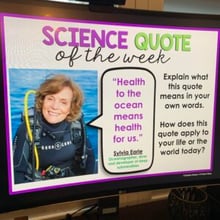HR Diagram Activities for Middle School Science
The resources below will provide students a comprehensive understanding of Hertzsprung-Russell diagrams. All of the following lessons are also included in the Kesler Science Membership.
The H-R Diagram 5E Lesson includes materials for every "E" phase, including the H-R Diagram Station Lab for Exploration and an interactive PowerPoint with digital INB templates for Explanation.
The lesson also includes introduction materials for Engagement, student-choice project ideas for Elaboration, and assessments for Evaluation.
After completing the H-R Diagram 5E Lesson, students will be able to classify stars by temperature and luminosity. They will also be able to compare stars from the H-R diagram.
The H-R Diagram Inquiry Lab is a hands-on activity that is differentiated for advanced, on-level, and modified middle school students.
Students will use data to interpret the H-R diagram. They will use data to graph a variety of stars such as main sequence, red giants, and white dwarfs to show their placement on the H-R diagram using temperature and luminosity as the variables.
The H-R Diagram Inquiry Lab includes a brief reading passage, comprehension checks, hands-on activities, reflection questions, and a CER conclusion.
H-R Diagram Classroom Experiences
Create a powerful student experience to help solidify students' understanding about H-R diagrams. All of the following experiences are also included in the Kesler Science Membership.
Escape Rooms
The H-R Diagram Escape Room is an immersive experience for your students. It allows them to demonstrate their knowledge of all of the Hertzsprung-Russell diagram.
Students must use what they have learned to describe components of the universe, including stars, nebulae, and galaxies, and use models such as the Hertzsprung-Russell diagram for classification.
STEM CHALLENGES
The Project, Star Gazer - Build an Interactive H-R Diagram STEM Challenge uses the engineering design process to create a 3D model of the H-R diagram on the wall.
Students will be using collaborative skills such as brainstorming with their peers and reflecting on their progress during the project.
At the end of the Project, Star Gazer - Build an Interactive H-R Diagram STEM challenge, students are given an opportunity to share their projects outside of the classroom.
Year-Round Resources
These year-round activities will increase your students' understanding of many middle school science topics. All of these activities are also included in the Kesler Science Membership.
Visual Data & Graphing
You're not alone if your students struggle with understanding graphs, charts, and tables. It's a skill that takes an enormous amount of practice. This resource will help students build a strong foundation in analyzing data and creating their own data visualizations.
Bell Ringers and Warm-Ups
These middle school science bell ringers are an excellent way to engage your students as soon as they walk into your classroom. This comprehensive FULL YEAR resource includes everything you need to start off each science class with an interesting warm-up activity.
Review Board Games
Each game board has been carefully designed to keep students engaged. There are 10 different action spaces on each board and dozens of question cards. All of the actions are related to science concepts and keep the students motivated throughout the game.
Each game is ready to play. Simply print out the board and the cards and let the students enjoy reviewing nine different units.
Essential Questions and Standards
Below are the essential questions and standards associated with the lessons and activities included in the H-R diagrams unit. This topic is only one of more than 100 middle school science topics included in the Kesler Science Membership.
-
What is the Hertzsprung-Russell diagram?
-
How is the H-R diagram used to classify stars?
-
TEKS Science 8.8 A - Describe components of the universe, including stars, nebulae, and galaxies, and use models such as the Hertzsprung-Russell diagram for classification
Kesler Science Membership
Imagine never having to search for another middle school science lesson again. The membership gives you access to ALL of the Kesler Science products in one place (Yes, including everything above).
Say goodbye to long hours of lesson prep.



